Searching for water damage repair companies? Look no further than our complete guide.
We’ll cover costs, common mistakes to avoid, and things to consider. Read on to learn more.
Need Water Damage Repair?
Seeing large amounts of water in your home is unsettling. Your possessions are at risk of being ruined.
But water damage to your home and appliances can be expensive and even dangerous.
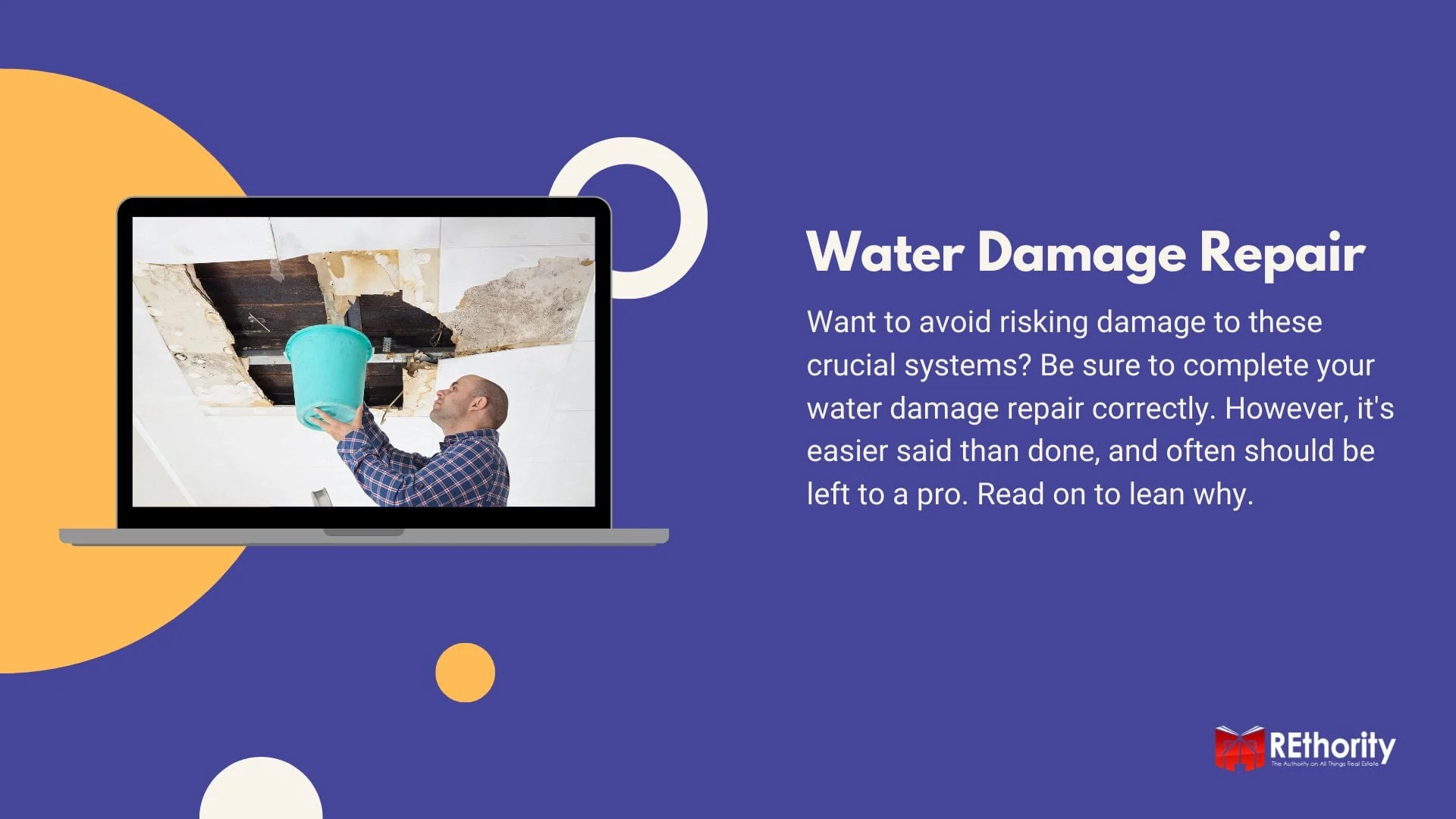
When you see pooling water in your home from any source, you have to do something quickly. Mold, fungus, and mildew will start to form in wet and humid conditions within 24 hours.
These substances don’t just smell unpleasant and look unsightly. They also pose serious health risks to anyone living in the home. But the risks don’t stop there. Water damage also weakens:
- Drywall
- Floors
- Plumbing pipes
- Electrical systems
- Even your foundation
Want to avoid risking damage to these crucial systems? Be sure to complete your water damage repair correctly. However, it’s easier said than done, and often should be left to a pro. Read on to learn why.
We partnered with Networx to help you find local plumbers in your area. Click to below to get a FREE quote.
Water Damage Sources
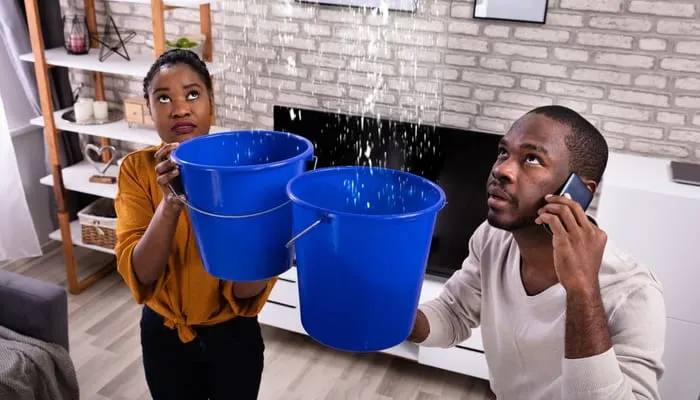
Andrey_Popov/Shutterstock
Water damage can come from many sources, including appliances and natural disasters. You might be experiencing water damage from:
- Thunderstorms
- Tornadoes and hurricanes
- Flooding
- Overflowing sinks, toilets, or bathtubs
- Sewage backups
- Leaking water-using appliances (water heaters, washing machines, etc.)
- Damage from fire hoses or fire sprinkler after a fire
Types of Water Damage
It’s vital to pinpoint your water damage source so you can know whether or not the water damage is safe for you to begin cleaning up.
There are three types of water damage you could encounter, depending on the source: Clean, Gray, or Black.
1. Clean Water
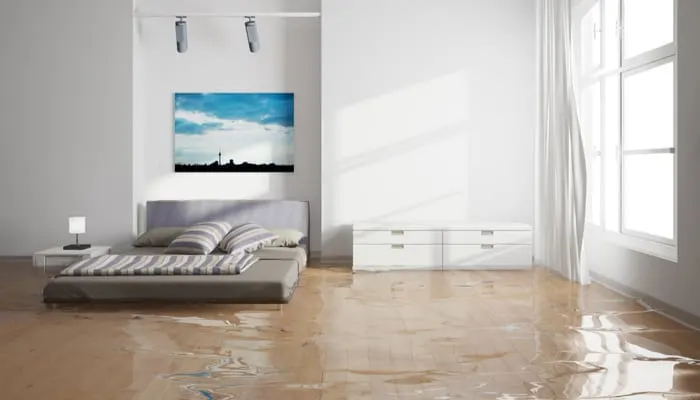
Robert Kneschke/Shutterstock
You may be dealing with damage from clean water if the water source is rain, leaky plumbing pipes, condensation, or any water source that has been treated and purified.
Clean water damage is the best-case scenario because it’s the safest type of water damage to clean up yourself. While this is easy enough to do, it’s just the first step in the process.
2. Gray Water
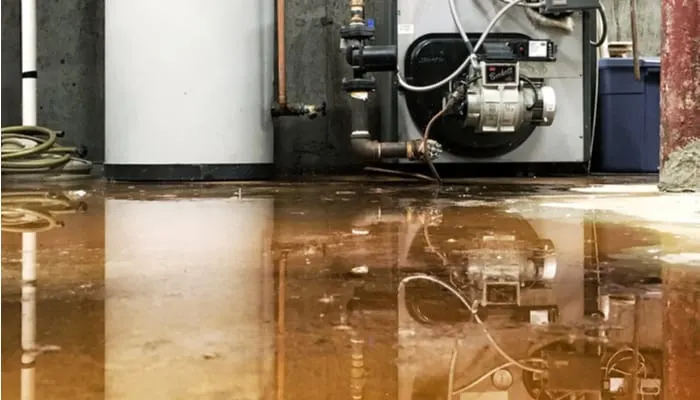
Helioscribe/Shutterstock
The second type of water you may experience water damage from is gray water. Gray water is not usually filled with bacteria and other contaminants, but it is not as pure as clean water.
There will likely be some organic matter in it because gray water has already been “used” somehow. Gray water typically comes from washing machines, dishwashers, and clean toilets.
Cleaning up damage from gray water requires some safety equipment if you plan to do it yourself. This includes rubber gloves, protective gloves, and in some cases, a hazmat suit.
3. Black Water
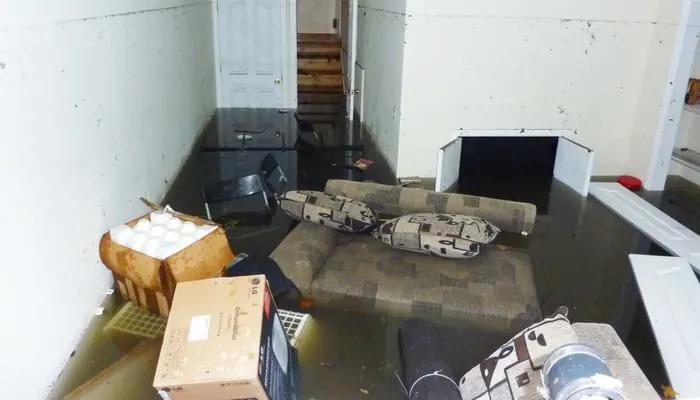
Leonard Zhukovsky/Shutterstock
The third type of water that could be the cause of your water damage is black water. This is the most dangerous type of water to deal with because it contains large amounts of bacteria, contaminants, sewage, parasites, and more.
You should never attempt to clean up water damage from black water. It may cause serious health problems and requires special safety equipment and an accelerated rate of cleanup to prevent long-term damage to your home.
Prepping for Water Damage Repair
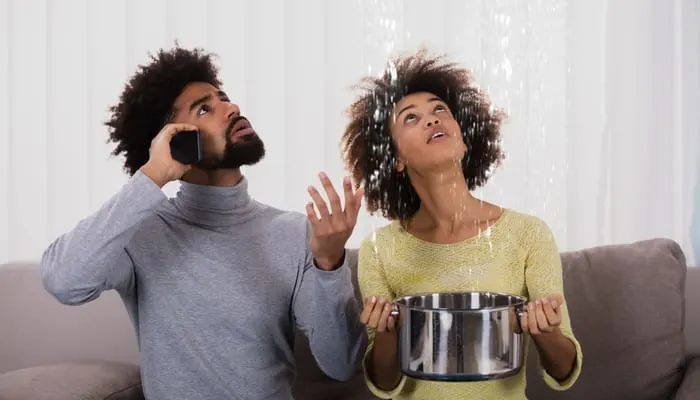
Andrey_Popov/Shutterstock
Once you discover water in your home, time is of the essence. You have to work quickly to prevent the resulting water damage from getting worse (and more expensive).
The first step as a homeowner is calling your insurance company. Let them know your plan, whether you plan to clean it up, or call a professional to handle it.
Remember, if you suspect black water is in your home, always call a professional. They have the proper safety gear, equipment, and techniques to quickly and safely rid your home of black water, gray water, and clean water.
Professional Water Damage Repair
Because water damage happens quickly, you’re better off calling in a professional for water damage repair. They bring the necessary equipment and gear needed to get rid of excess water fast.
They also dry out the area, disinfect and kill disease-causing organisms, and make the repairs that may be needed afterward. Here’s what you can expect when you call a professional water damage repair company.
1. Inspect and Assess the Damage
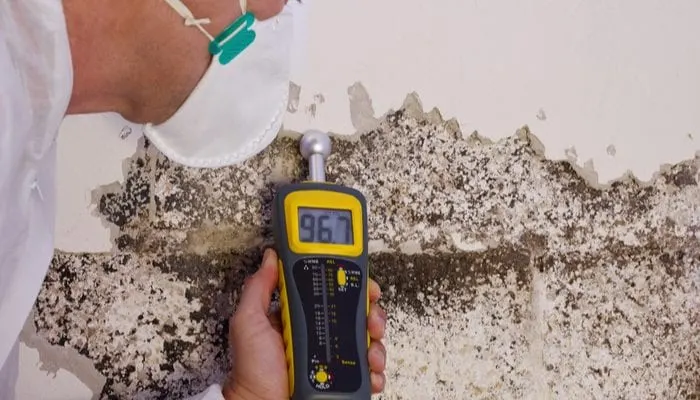
PPC Photography Cologne/Shutterstock
After you call a professional and let them know you have a water damage emergency, repair specialists will come to your home and inspect it to determine the amount and source of water damage.
The cause and type of water damage will let them know what kind of gear and equipment they need to get the job done safely and correctly. They have the necessary equipment and gear with them in the truck.
If any furniture or belongings are in the area with standing water, they move them for you to prevent further damage. Even better? Most companies also provide a satisfaction guarantee.
2. Water Removal
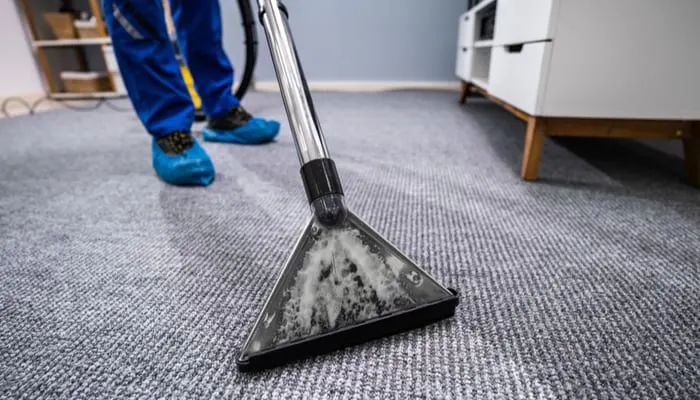
Andrey_Popov/Shutterstock
Whether you’re dealing with an inch or a few feet of water in your home, the repair technicians use powerful vacuums and pumps to quickly remove standing water much faster than can be done manually.
The faster water can be removed, the less time it has to permanently damage your home and create breeding grounds for mold, mildew, and fungus.
If you have carpeting in the area with water damage, they will inspect the carpet and pad to see if they can be thoroughly dried in the next step. If they are completely soaked beyond repair, the team removes it.
3. Dry the Area
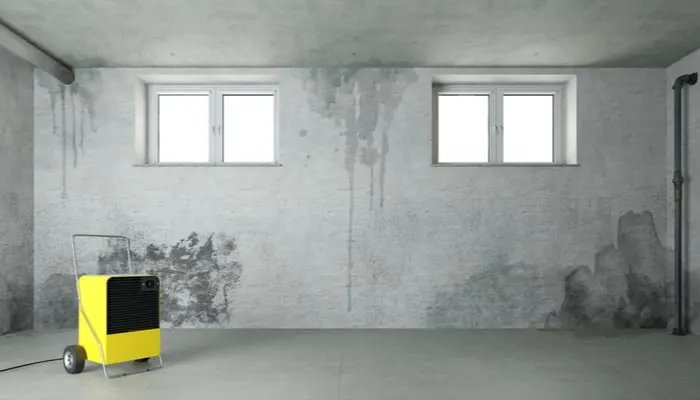
Robert Kneschke/Shutterstock
Heavy-duty air movers and dehumidifiers enable professionals to dry out the affected area quickly. This equipment penetrates hard to reach spaces and draws excess water from partially soaked structures.
It’s essential to make sure the area is completely dry to prevent mold, fungus, and mildew from forming and creating unsafe air hazards. Another benefit of hiring a professional for water damage repair is their use of moisture meters.
When you attempt to dry out an area on your own, looks can be deceiving. Walls and floors that look dry may still hold enough water to warp and damage them.
Moisture meters allow professionals to know when the area is truly dry, so the next step can begin. Jumping the gun can make your restoration efforts fruitless.
4. Sanitize and Disinfect
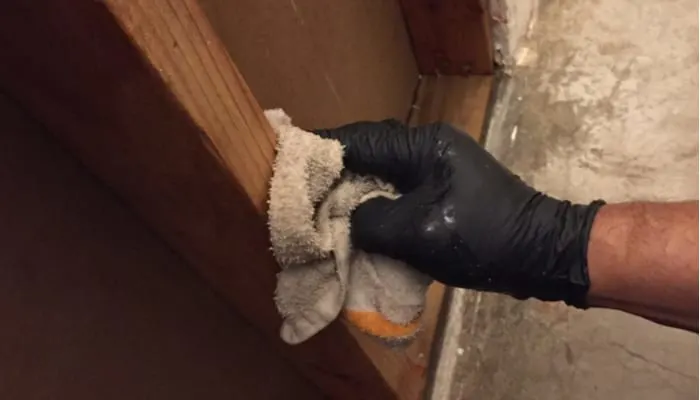
Abraham Wilson/Shutterstock
Standing requires disinfection and sanitization to make sure the area is safe afterward. Any items affected by the water damage need to be cleaned.
This ensures they’re not holding dangerous bacteria, mildew, mold, or fungus. The area can also develop an offensive odor if it isn’t properly cleaned and sanitized by a professional.
Your water damage repair specialists might use a combination of the three types of water to clean, sanitize, and disinfect your belongings:
- Dry and wet cleaning
- Foam cleaning
- Abrasive cleaning
- Immersion cleaning
- Antimicrobial and/or antibacterial treatments
- Sanitization and disinfection
- Use of industrial air scrubbers to remove odors
- Use of fogging equipment to remove odors
- Proper disposal of severely damaged items (with your consent)
5. Water Damage Repair and Restoration
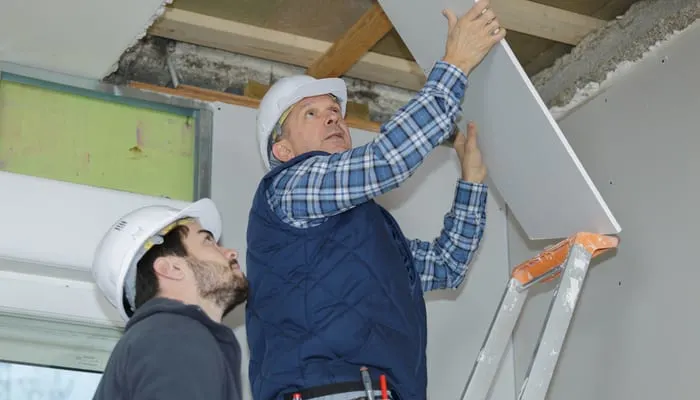
Alpa Prod/Shutterstock
Finally, the water damage specialists will take on any additional repairs that need to be done to bring your home back to its pre-damage state.
If carpet, flooring, drywall, or wooden wall structures were damaged by water, the team would cut out the damaged areas and replace them.
Your water damage repair company should be able to handle repairs from the most minor to full reconstruction of an affected room or area.
DIY Water Damage Repair
If you are dealing with clean or gray water, you might be considering doing the cleanup yourself. However, even clean and gray water pose risks to your home if not cleaned and repaired by a professional.
If you decide to handle the cleanup process yourself, make sure you have the following items for safety and efficiency during the cleanup:
- Long pants and long sleeves
- Gloves
- Goggles
- Rubber boots
- Respirator mask
- Lots of towels
- Buckets
- Mops
- Wet-dry vacuum or sump pump
- Extension cord with ground fault circuit interrupter
1. Get Rid of Standing Water
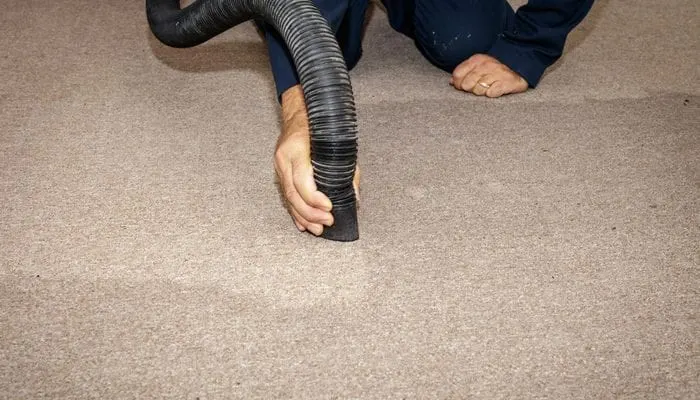
Jens Lambert/Shutterstock
After you and your cleanup crew are properly dressed and wearing safety gear, start soaking up as much water as you can with towels and mops, wringing them out into buckets as you go.
You should be able to dump the buckets of water down drains in your home. If not, you can dump the buckets of clean or gray water onto your lawn.
Be especially careful if you are using a wet-dry vacuum or a sump pump. Only use outlets that are a safe distance from the water and never use an outlet that has been underwater.
If in doubt, leave it alone and call a professional to come in and complete the cleanup. In any case, it’s essential to work quickly! Major risks can occur if you wait.
The longer water sits, even if it’s just an inch or two, it’s degrading your drywall’s integrity and the structure of your home. This is why it’s a good idea to enlist the help of friends and family.
Many hands make light work and help this process move faster, reducing the overall amount of water damage done to your home.
2. Dry the Area Out
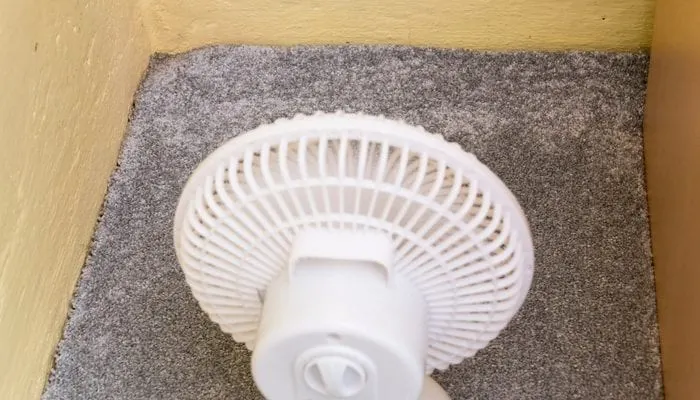
Lapis2380/Shutterstock
This can be a difficult step if you’re tackling water damage repair on your own. Without the equipment that most professionals use, it’s impossible to know if you’ve thoroughly dried an area.
Gather any fans you have (oscillating fans help move air around the room) and a dehumidifier (a heavy-duty commercial dehumidifier is best) to speed along the drying process.
Place the fans in different locations to increase the amount of air circulating around the room. If it’s not raining or especially humid outside, open any windows in the room to speed up drying.
If you can see that your drywall and baseboards are wet, take action now. Pry the baseboards away and see if they can be saved. Real wood baseboards may dry out.
But pressboard baseboards will swell with any contact with water and need to be replaced. Once the baseboards are removed, cut the affected parts of drywall away and dispose of them.
Wet drywall will not regain its strength once dry, and the paper backing makes it susceptible to harboring mold and mildew. Be sure to leave fans and dehumidifiers running for a few days.
Larger areas may require a week or more to dry out completely. Because there are so many variables, it’s always best to call a pro right away.
3. Sanitize and Disinfect
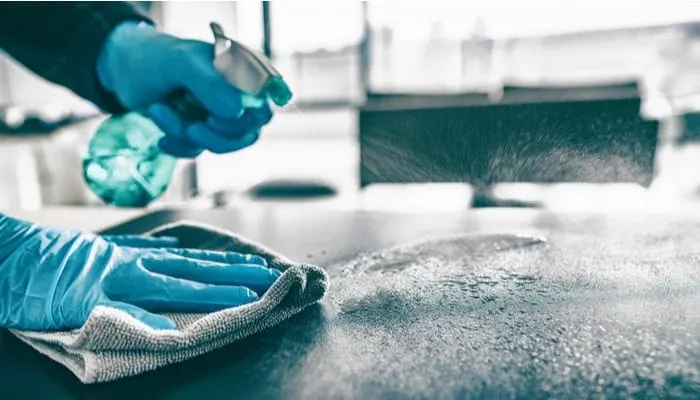
Maridav/Shutterstock
Once the water-damaged area is dry, you’ll need to sanitize and disinfect the area and any affected ones. This includes walls, baseboards, furniture, appliances, and personal belongings.
As you clean, work from the top to the bottom to avoid spreading bacteria, mold, mildew, or fungus. You can use a bleach solution of 1/2 cup bleach in one gallon of clean water on color-fast items.
Otherwise, look for an all-purpose disinfecting cleaner and follow with a quick rinse of clean water afterward. Be sure to wear protective gear. And spot-test the mixture to avoid ruining a surface.
4. Dispose and Recycle

Any items that were not salvageable should be adequately disposed of, and if possible, recycled. You can usually recycle water damaged electronics, furniture, and drywall.
But be sure to check with your local waste management department to check first. Otherwise, damaged items should be thrown away to prevent mold and mildew from forming inside.
Water Damage Repair Costs
According to Homeadvisor.com, the average homeowner spends between $1,142 and $4,731 to restore or repair water damage, with an average of $2,907.
A licensed water damage repair professional determines the cause and extent of the destruction. They also categorize and classify the damage to your home — the two largest factors in figuring the final bill.
Water damage repair costs differ based on a few factors:
- Extent of the damage
- Area of the home the damage occurred in
- Type of water responsible for the damage
Below are the average costs for water damage repair in the United States). While these are not blanket prices, it’ll give you an idea of what to expect when hiring professional water damage repair.
Average Total
- Average: $1,142 to $4,731
- Mean cost: $2,907
Cost per Square Foot
- $3.75 per square foot for clean water damage cleanup
- $4.50 per square foot for gray water damage cleanup
- $7.00 per square foot for black water damage cleanup
Tips From the Pros
What better way to learn about a topic than to hear advice directly from a pro? We’ve rounded up a few water damage repair pros to help you understand what you’re dealing with.
[su_testimonial name=”Bud Summers” photo=”https://rethority.com/wp-content/uploads/2020/07/BudSummers-RGB-1-scaled.jpg” company=”PuroClean” url=”https://www.puroclean.com/about-us/executives/”]“When considering a restoration company for water damage in your home, ask if the technician has been certified by the Institute of Inspection, Cleaning and Restoration Certification or IICRC. A technician should hold at minimum, IICRC certificates in Water Restoration & Applied Structural Drying.”[/su_testimonial] [su_testimonial name=”Brad Fishbein” photo=”https://rethority.com/wp-content/uploads/2020/07/Annotation-2020-07-08-082059-1.jpg” company=”LookMold” url=”https://www.linkedin.com/in/brad-fishbein/”]”Hidden mold within the walls must be accounted for when discovering a water leak. Mold can grow within 48 hours under the right conditions. Just because you don’t see mold on the surface of the walls doesn’t mean you won’t encounter any during removal.”[/su_testimonial] [su_testimonial name=”Kershan Bulsara” photo=”https://rethority.com/wp-content/uploads/2020/07/word-image-1698-1.jpg” company=”Roofmaster.com” url=”https://www.linkedin.com/in/kershan-bulsara-076b2970/?originalSubdomain=ca”]”Water leaks can spring from air conditioners and HVAC systems, various plumbing problems, and even condensation from your showers and appliances can cause water leaks if your home does not have the proper ventilation system. With all that being said, if you think the leak may be coming from your roof, the best thing you can do is call a professional to inspect your roof for damage and other potential leaks.”[/su_testimonial]Should You Call a Professional for Water Damage Repair?
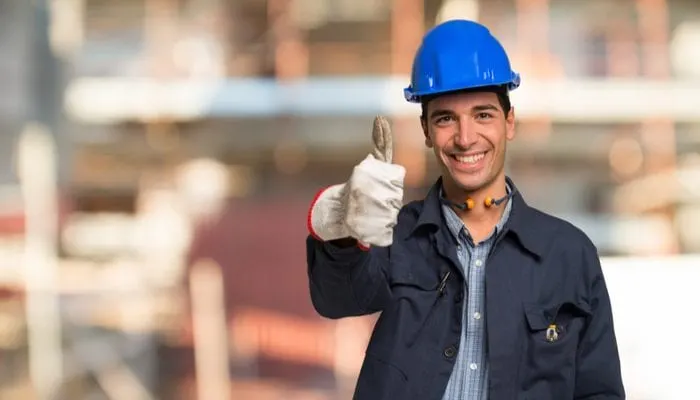
Minerva Studio/Shutterstock
Water damage can be a nightmare for homeowners, but if you take action quickly, you can prevent additional damage to your home, health, and personal items. Professionals recommend not taking the risk of attempting to clean it up on your own.
Trying to do it yourself exposes you to a few risks:
- Dangerous pathogens
- Risk of electrical shock
- Leaving water and dampness in hard-to-reach areas
- Create a breeding ground for mold and mildew
Calling a professional is the clear choice when you notice standing water anywhere in your home. They have the experience, equipment, and techniques necessary to safely and effectively remove water before mold, mildew, and fungus start to grow.
Call a local company experienced in water damage repair when you see water in your home – the faster you call, the more of your home you can prevent from being damaged.
Even better? We partner with Networx, an industry-leading contractor database. Simply enter your information and the system automatically pairs you with contractors equipped to handle the job.
We partnered with Networx to help you find local plumbers in your area. Click to below to get a FREE quote.
So, Should You Hire a Pro for Water Damage Repair?
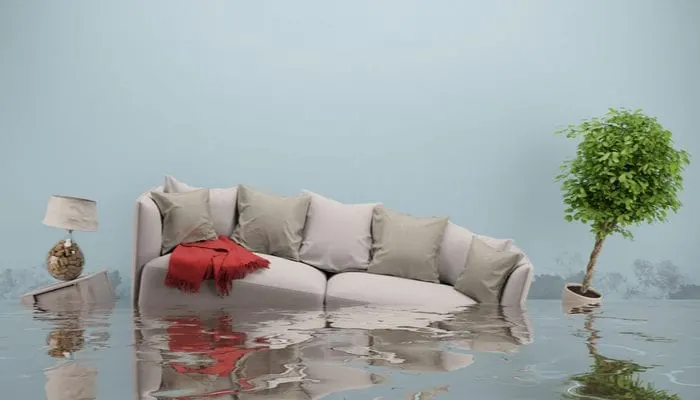
Robert Kneschke/Shutterstock
Water damage repair can be done DIY, but it’s a huge liability if you do it wrong. It’s best to call a pro.
Fortunately for you, our form makes it easy to do just that! Scroll up to connect with a local water damage restoration vendor today.


